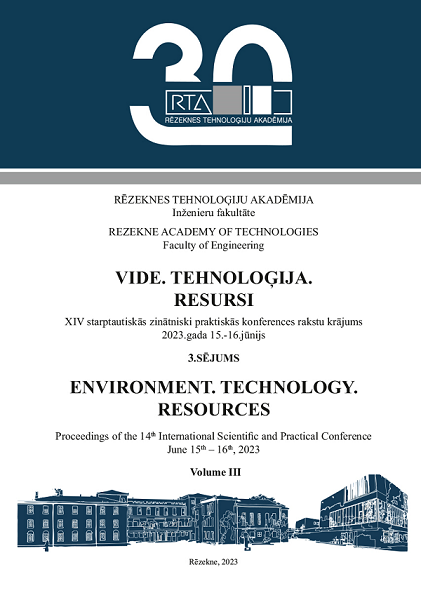RESEARCH OF THE PRINCIPAL MODEL OF THE ELECTRIC ENERGY GENERATOR OF THE ELECTRIC CAR (STAGE COMBINATION OF MECHANICAL AND ELECTROMECHANICAL PARTS)
DOI:
https://doi.org/10.17770/etr2023vol3.7261Keywords:
robotic system, electricity generator, regeneration, electricity, windAbstract
The article presents the interim results of the ongoing study (http://journals.ru.lv/index.php/SIE/article/view/6884/5683). At this stage, measurements are made with a model in which we combined the mechanical part with the electromechanical part. At the presentation stage, a model demonstrating the principle operation scheme of the patented device has already been constructed as an object of research. A rotating magnet was connected to the impeller (it was rotated by the impeller). The magnet was rotating around the stationary coils and was already inducing an electric current in the coils. In this way, the generated current and generated voltage values can be used as an indicator for evaluating the efficiency of the impeller. The experiments in question are performed with three impellers of different configurations, keeping other conditions analogous. All experiments were performed using only one rotating magnetic ring and one set of stationary coils. The results of experimental measurements show a wide spectrum and possibilities of increasing efficiency and demonstrate the principle of operation of the future device. When designing an impeller with turned wings, two cavities for magnets and coils are already provided, thus preparing for the next step in improving the design of the model under study and increasing efficiency.
References
R. P. Murkund, Wind and solar power systems: design, analysis, and operation. Boca Raton, 2006.
Lithuania Wind Assotiation, “Viskas, ką reikia žinoti apie vėjo energetiką“, 2020. [Online]. Available: https://lvea.lt/wp-content/uploads/2021/01/LVEA_Viskas-ka-reikia-zinoti-apie-vejo-energetika.pdf [Accessed: April 26, 2023]
L. Augulis, A. Jotautis and D. Rutkunienė, Fizika: mechanika, termodinamika, elektromagnetizmas: mokomoji knyga, 2012. [Online].Available: https://www.ebooks.ktu.lt/eb/656/fizika_mechanika_termodinamika_elektromagnetizmas/ [Accessed: April 26, 2023]
V. Matutis and M. Matutis, “Patent description”, 2019. [Online]. Available:https://worldwide.espacenet.com/patent/search/family/068887188/publication/EP3840192A1?q=EP3840192A1[Accessed: April 26, 2023]
G. Boyle, Renewable energy: power for a sustainable future. Oxford University Press, 2012.
V. Matutis, L. Savulioniene, P. Sakalys and T. Kasperavicius, “Energy Generator Prototypes Development and these Research Integration into the Educational Process”, Society. Integration. Education. Vol 1, 2022. [Online]. Available: http://journals.ru.lv/index.php/SIE/article/view/6884/5683 Accessed: April 26, 2023]
A. Betz, Das Maximum der theoretisch möglichen Ausnützung des Windes durch Windmotoren. Zeitschrift für das gesamte Turbinenwesen. Germany, 1920, pp. 307-309.
V. Matutis, L. Savulioniene, P. Sakalys, T. Kasperavicius, “Research of Power Generator Prototype Development and Integration into Autonomous Robotic Systems”, Society. Integration. Education. Vol 5, 2021. [Online]. Available: https://doi.org/10.17770/sie2021vol5.6453 Accessed: April 26, 2023]



